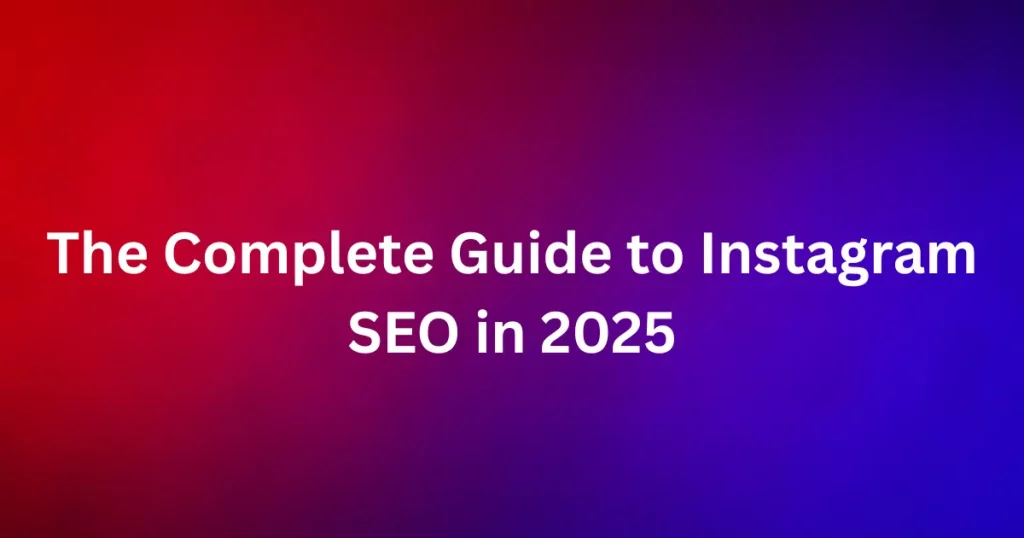The Complete Guide to Instagram SEO in 2025

Instagram’s search function has evolved beyond just hashtags and usernames. Now, it prioritizes content relevance, engagement, and user intent just like Google.
Key Ranking Factors in 2025:
- Keywords in Captions & Alt Text – Instagram now scans captions and image descriptions for search intent.
- Engagement Velocity – How quickly your post gets likes, comments, and shares.
- Dwell Time – How long users stay on your Reels or posts before scrolling.
- Profile Authority – Accounts with consistent posting and high trust rank better.
- Search History & User Behavior – Instagram personalizes results based on past interactions.
Example: If someone searches “best running shoes for flat feet,” Instagram will show:
- Posts with that exact phrase in the caption
- Reels with high watch time on that topic
- Accounts frequently engaged with by runners
Step 1: Instagram Keyword Research (2025 Methods)
Before optimizing, you need to find high-traffic, low-competition keywords.
Best Free Tools for Instagram SEO Research:
🔍 Instagram Search Bar – Start typing a phrase to see autocomplete suggestions.
🔍 AnswerThePublic – Finds long-tail questions people ask about your niche.
🔍 Google Keyword Planner – Check search volume for related terms.
🔍 Meta Business Suite – Shows trending topics in your industry.
Pro Tip: Target long-tail keywords (e.g., “vegan meal prep for weight loss” instead of just “vegan recipes”).
Also Read: How to Use Instagram for Business?
Step 2: Optimizing Your Posts for Instagram SEO
1. Captions That Rank
- Use your target keyword in the first line.
- Keep captions under 125 characters for preview visibility.
- Include a CTA (e.g., “Double tap if you agree!”) to boost engagement.
Example of an SEO-friendly caption:
*“Struggling with gluten-free baking? � This 3-ingredient cookie recipe is foolproof! 👇 #GlutenFreeDesserts #HealthyBaking”*
2. Hashtags: Less Is More in 2025
Instagram now penalizes spammy hashtag use. Best practices:
- Use 3-5 highly relevant hashtags (mix of niche and broad).
- Avoid banned or overused hashtags (#love, #instagood).
- Create a branded hashtag for community growth.
3. Alt Text for Images & Reels
Since Instagram can’t “see” your photos, manually adding alt text helps with rankings.
- Go to Advanced Settings > Alt Text before posting.
- Describe the image naturally, including keywords.
Example:
❌ “Food”
✅ “Homemade chocolate chip cookies on a marble countertop”
Step 3: How to Rank Reels & Stories in Search
Reels SEO Tips for 2025
- Put keywords in the on-screen text (Instagram scans this).
- Hook viewers in the first 0.5 seconds to increase watch time.
- Use trending audio (but add custom captions for SEO).
Stories SEO Hack
Since Stories disappear after 24 hours, use Highlights with keyword-rich titles (e.g., “Workout Tips” instead of “Fitness”).
Also Read: The rise of silent reels
Step 4: Advanced Instagram SEO Strategies
1. Collaborate with High-Authority Accounts
Instagram ranks posts higher if shared by credible profiles. Try:
- Guest Reels with influencers in your niche.
- Shoutout exchanges with similar-sized accounts.
2. Post at Least 3x Per Week
Consistency signals to Instagram that your profile is active and trustworthy.
3. Encourage Saves & Shares
Posts with high bookmark saves rank better because they indicate long-term value.
Biggest Instagram SEO Mistakes to Avoid
❌ Ignoring video SEO – Reels dominate search results in 2025.
❌ Using generic captions – No keywords = no rankings.
❌ Buying fake engagement – Instagram detects bots and shadowbans accounts.
Final Thoughts
With Instagram pushing SEO-friendly features, brands that optimize now will dominate search results in 2025. Start by:
- Researching low-competition keywords.
- Optimizing captions, alt text, and hashtags.
- Creating high-retention Reels.
Need help? Track your rankings by searching your keywords weekly and adjusting your strategy!
